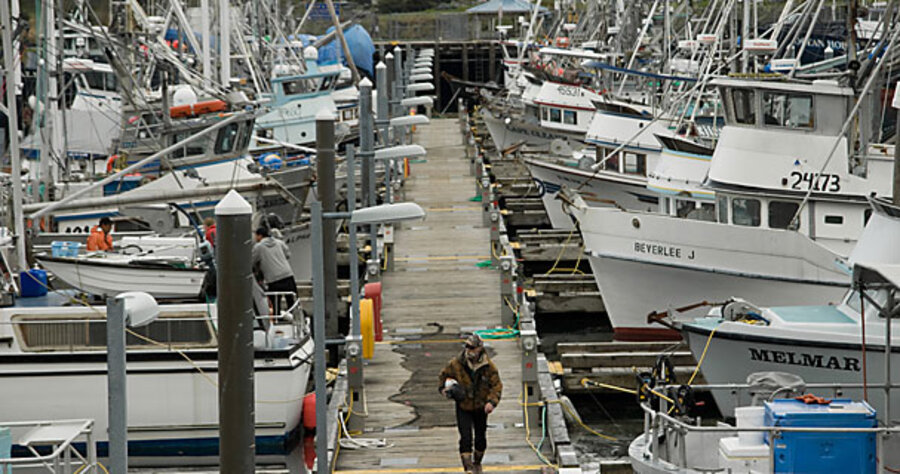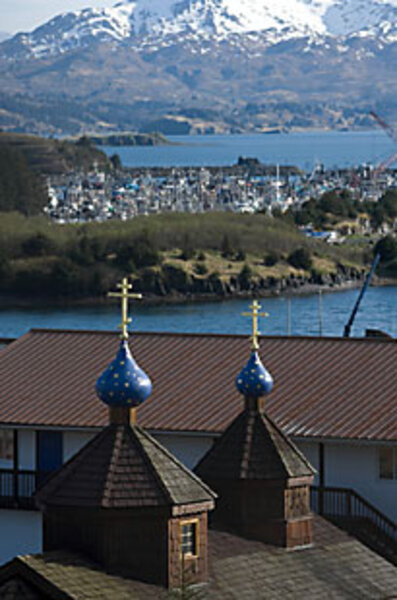Alaska fishing: the merits and costs of a tamed frontier
Loading...
| Kodiak, Alaska
Gobble a fast-food fish sandwich, snack on fish sticks, or savor a fancy white-tablecloth seafood dinner and chances are you’re sampling the fruits of what experts say are the nation’s best-managed commercial fishing grounds. While fisheries are collapsing around the world, stocks are strong in the waters off Alaska, source of half the seafood commercially harvested in the nation. Pollock, halibut, Pacific cod, and sablefish taken from these northern waters bear the Marine Stewardship Council’s seal of approval lauding the cautious oversight of federal fisheries managers. So do the harvests of Alaska’s five species of salmon, which are caught in state waters and managed under a separate state system; they were the first to be classified by the international watchdog group as “sustainable.”
Those who manage fisheries in Alaska’s federal waters – the Anchorage-based North Pacific Fishery Management Council and associated federal agencies – are generally credited by outsiders for doing a good job. “We have a lot of respect for them,” says George Geiger, chairman of the Florida-based South Atlantic Fishery Management Council, who was visiting his Alaska counterparts at work at a week-long meeting in Kodiak earlier this month.
Fishery management in the federal waters off Alaska is considered the standard for the rest of the nation; federal legislation enacted in 2007 requires managers in other regions to adopt some of the resource-protection practices long used here. It may also hold lessons for fisheries worldwide.
But to hear some tell it, Alaska’s legendary fisheries are on the brink of disaster – a socioeconomic crisis if not a biological collapse. The spread of “rationalization” in the federally run fisheries – marketable harvest quotas for finite amounts of fish – has made the business more efficient, predictable, orderly, and manageable. It may even help lift impoverished Native communities. But it has also created instant fortunes for some and left many longtime and would-be fishermen on the docks.
Since the mid-1990s, managers have imposed various transferable quota systems on those who fish commercially in federal waters, replacing the old open-access “anyone can fish” system with one that inevitably limits participation to professional and corporate interests flush with capital.
That is not an overly dramatic shift for the Bering Sea, source of most of the seafood harvested in Alaska, because commercial fisheries are relatively new there and have been industrial and corporate-dominated from the start.
But the gradual fencing, in effect, of the Alaska high-seas frontier is a bitter pill in a hard-core fishing town like Kodiak, where the locals are old-school, independent mariners who take relatively small volumes of various species to patch together year-round employment.
In Kodiak, fishing and fish permeate life, fueling both the human economy and the legendary brown bears that roam the lush, mountainous island. The names of boats docked at the sprawling harbor – Hail Mary, Dues Payer II, Spicy Lady – hint at an on-the-edge lifestyle. Even the clergy from the local Russian Orthodox seminary sport fishing boots under their flowing black robes. And “ratz,” as rationalization is known here, has become a dirty word among those who say Kodiak is losing out as quota systems spread.
“It’s just a way of people getting hold of the resource. It’s all about greed,” says Rhonda Maker, a Kodiak store owner who says she was pushed out of fishing because she was too small a player to win significant quota shares. Now her new career as a retailer is being undermined, she says, by fewer cash-flush fishermen coming to her two stores here.
The latest controversy involves a new crab system imposed on the Bering Sea in 2005. It shrank the harvest fleet from some 250 boats to about 85 and eliminated some 800 to 900 jobs. While the complicated system gave quota shares to boat owners, skippers, and processors, it left out crewmen. It had a strong effect here, where many locals would sail off to the Bering Sea crab grounds for an important part of their yearly income.
In Kodiak, that first full year of crab rationalization cut the number of local boats participating in the fishery in half and the community lost $1 million to $1.6 million in revenue, according to a study by University of Alaska Anchorage economist Gunnar Knapp.
Particularly galling to some here is the idea of fishing for somebody else, toiling on the cold sea while the quota owner takes a cut of the profits while ashore.
“It’s the American way, but it’s just not fair. It’s fishing. It’s not a typical business,” says Kavik Anderson, preparing his boat. He shouts over the noise of a pressure washer cleaning off a nearby boat at the dock. “The processors got stuff. The owners got stuff, and the crew members didn’t get anything. It’s just not fair.”
Fisherman Stosh Anderson, Kavik’s father and a former North Pacific council member, dislikes some of the social outcomes of the new management systems. “If you weren’t born with a silver fishhook in your mouth or your family’s not in the industry, it’s going to be very tough for you to get into the industry,” he says, as he and his crew prepared his newly rebuilt boat for salmon.
What to many in Kodiak is disenfranchisement is to economists a reasonable and inevitable evolution that brings order to the resource-imperiling and unsafe chaos in the ocean “commons.”
“In general, with the right set of rules and the right design – which is always a big ‘if’ – going to a rights-based fishery is going to improve the value of the fishery,” says Jim Murphy, an economist and visiting professor at the University of Alaska Anchorage. Of the four rationalization goals – conservation, enhanced value, reduced costs, and social fairness – the Alaska schemes, overall, “have done well in all but one,” Professor Knapp says. The designation of winners and losers makes fairness elusive, he says. “If there was ever a situation where the devil was in the details, this would be it,” he says.
For some in Kodiak, the changes have been good, even for crab.
“I think the council’s done a good job with the crew,” said Jeff Steele, a local fishing captain, in testimony to the council’s advisory panel. “I think they should be up here thanking you for better jobs, and better pay, and safer conditions....”
Before the Magnuson-Stevens Fishery Conservation and Management Act of 1976 established the 200-mile US exclusive economic zone off the nation’s shores, Alaska’s remote high seas were wild and free – and fished by whoever could get to them. By the 1990s, quota systems were being drawn up for pollock, halibut, and other species.
Around Alaska, the halibut system that went into effect in 1996 gets general high marks. By that time, there were so many fishermen targeting halibut in the open-access system that the seasons were reduced to two 24-hour fishing “derbies” a year, events that become notorious for shoving vast amounts of low-quality fish onto the market all at once, and for the sometimes life-threatening risks that fishermen took to get their catches.
Now halibut harvests are spread out over several months, putting more valuable fresh fish on the market instead of having almost all of it sold frozen. With quota holders knowing how much fish they can land, fishermen can take their time and work carefully and safely.
Also lauded is a community-development quota system that allocates a small portion of the huge Bering Sea catches to once-impoverished native villages along Alaska’s west coast. Though relatively small, their quota shares can be powerful local economic engines. The villagers’ success shows that quotas, instead of making the rich richer, “can be a device to make the poor richer,” Knapp says.
Some alternate allocation ideas have been floated in academic and political circles. One would make quota shares temporary and subject to expiration after a number of years. Another would establish quotas linked to specific geographic spots rather than a particular species, to encourage more holistic, multispecies management.
The North Pacific Fishery Council has always respected the advice of its Scientific and Statistical Committee, never exceeding the total catch limits recommended by that panel of wonky biologists and technicians. Bycatch is taken seriously, too, with punishment meted out when too many fish of nontargeted species are netted in the harvest. Vast areas have been put off limits to protect habitat for fish,
Endangered Species Act-listed mammals, and newly mapped coral gardens. (See related story: “Alaska’s coral gardens: Scientists race to save unexplored wonders.) The council is trying an ecosystem-based management approach for the Aleutian Islands to avoid damaging natural resources about which much is yet unknown
The council is also moving to formally block off Alaska’s Arctic waters to commercial fishing before a warming climate and vanishing sea ice draws fish stocks northward. Too little is known about the changing Chukchi and Beaufort seas to allow commercial fleets to rush in, officials say. “Here, we’ve kind of inverted the burden of proof,” says Denby Lloyd, commissioner of the Alaska Department ofFish and Game and a member of the North Pacific council.
Still, there are holes in the protections.
Last year’s high-seas pollock harvest netted as bycatch a record number of river-bound chinook salmon, raising alarms in small salmon-dependent villages. At the Kodiak meeting, the North Pacific council gave preliminary approval to a new rule that could shut down the nation’s biggest single-species harvest entirely if similarly high chinook bycatch numbers are approached next year.
There are constant disputes over the extent and location of protective zones. The bans on bottom trawling protect areas where there was no such seafloor-scraping fishing in the past, for example, but did nothing for previously damaged sites, says Dorothy Childers, program director for the Alaska Marine Conservation Council. “There’s still a lot of coral habitat that has been exposed to bottom trawling, and there’s a lot of habitat that has been mowed under,” she says.
Some of the quota programs have had unintended environmental consequences, such as fishermen purposely targeting species that are supposed to be incidental bycatch. In the first year of the crab program, “high-grading” skyrocketed as large numbers of legal-sized crabs were thrown back because they failed to meet the precise specifications preferred by seafood processors with quotas linked to the boats’ quotas.
Anyone who expects the invisible hand of rationalization to automatically result in resource conservation should look elsewhere, says Ms. Childers. Clean fishing, whether under quotas or open-access, has to be specifically mandated, she says. “The improvement that can be made under a rationalized system is that you can fish more slowly – but you have to fish more slowly,” she says.






